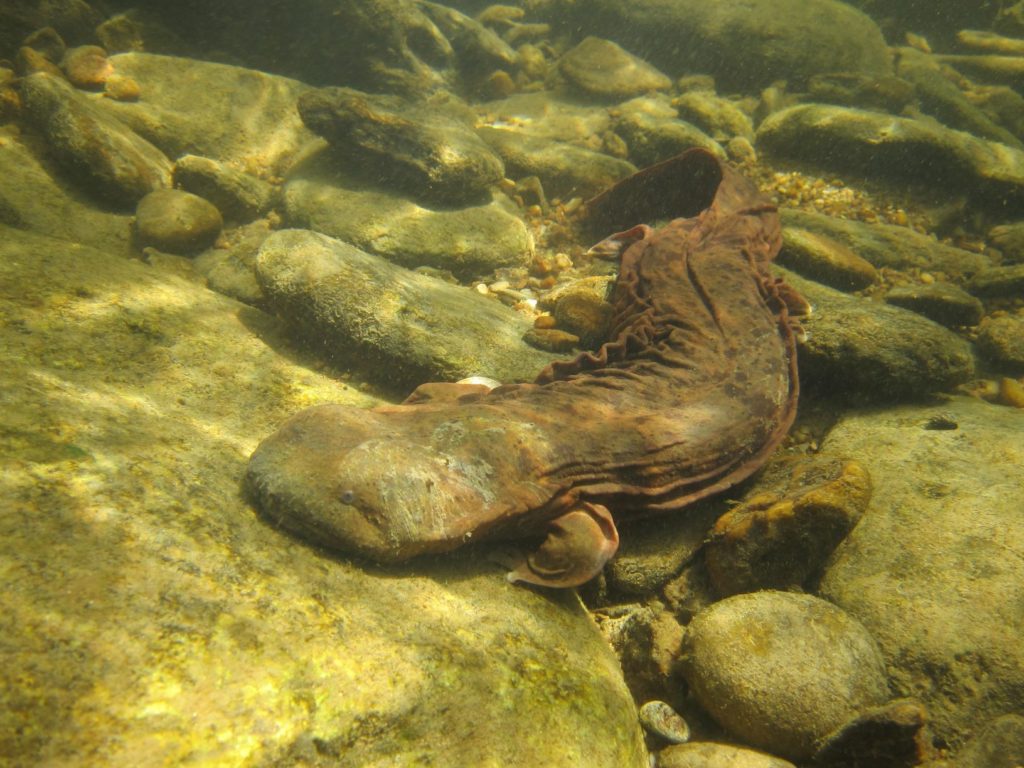
Did you know one of the three giant salamanders in the world lives in the Watauga River?
The Eastern hellbender can grow 2-feet long or more during its 30-year lifespan. They look prehistoric. Coming from an ancient lineage of salamanders, its body form has changed little over millions of years.
When Michael Gangloff, associate professor of Freshwater Conservation Biology at Appalachian State, arrived in Boone more than a decade ago, he needed something to work on. With hellbenders being rare and indicators of water quality, he was drawn to them.
“Plus, they are really charismatic, which is a nice change if you’re used to working with freshwater clams. Those don’t even have a head,” Gangloff said. “But historically, hellbenders were the apex predator in a lot of streams around here, and so were probably really important in determining the structure and function of historical mountain ecosystems.”
Today, though, they are just one of many predators in Eastern United States streams.
For example, Gangloff said it’s believed that 50 percent of all fish species in the New River Drainage are introduced. So while the food web of these rivers have certainly changed over the years, the hellbender helps biologists understand what stream conditions were “before people came and changed everything.”
Hellbenders, like wild trout, prefer larger streams with cold and clean waters, a rocky substrate and a high gradient, according to wildlife profile of the Eastern hellbender by the N.C. Wildlife Resources Commission.
Rapids and swift currents create dissolved oxygen, which these giant salamanders absorb through gill slits on its skin once they turn 1 ½ to 2 years old. They are born with external gills.
Searching for the ‘Denmasters’ of the River
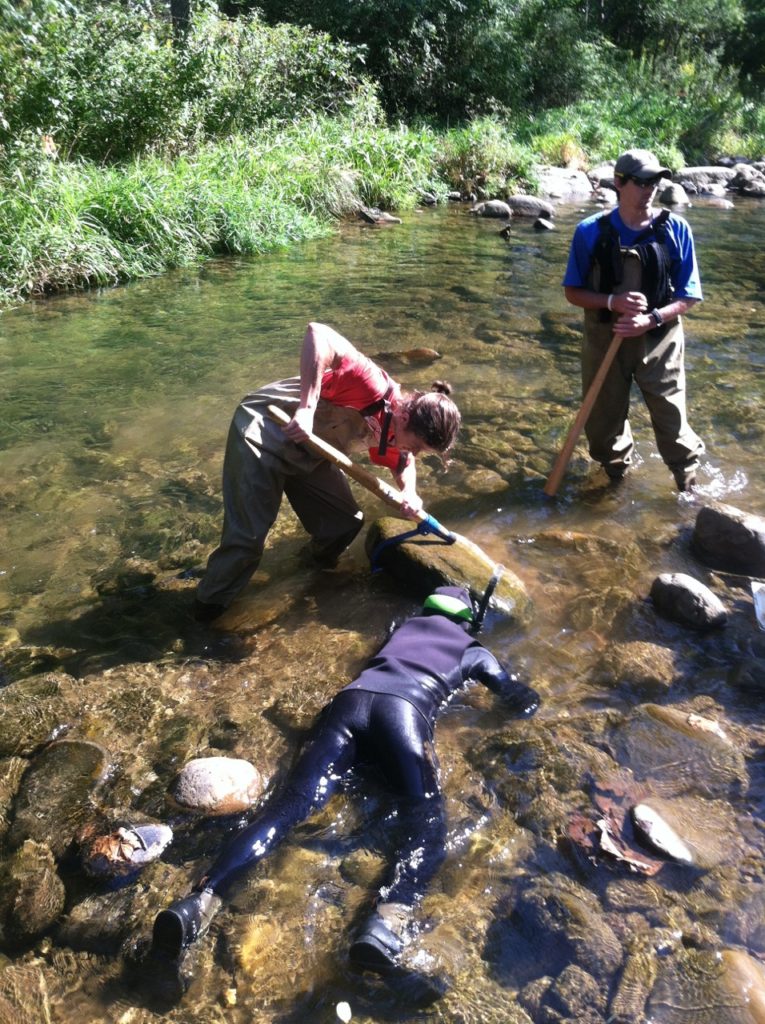
In early summer, Gangloff and a team of researchers from Appalachian State go to nearby streams, including the Watauga River, to conduct surveys of local hellbender populations.
They used to wear snorkel gear and lift big rocks to catch and document salamanders, but they are moving away from that method. Any rock turning done, though, happens before mid-August because of nesting season.
Male giant salamanders are referred to by biologists as “denmasters.”
They dig nests and then are hell-bent on defending those during nesting season. Hellbenders shelter and lay eggs under large rocks and submerged trees or logs.
Instead of potentially disturbing the hellbenders’ habitat by removing them from the water, researchers are turning more and more to observing the nocturnal critters at night.
“They’re pretty much hanging out in crevices, beneath boulders and bedrock and are sometimes observed moving about the stream bed at night. Rock openings are basically their feeding stations,” Gangloff said. “They are waiting for crayfish and small fish to cruise past their little ambush spot.”
Gangloff estimates that 10 to 20 hellbenders can be found in just a 150-meter section of stream in parts of the Watauga River Drainage that support proper conditions for healthy population numbers.
The range of Eastern hellbender includes most of the Watauga River watershed, the N.C. mountains and greater Appalachia, in rivers that eventually drain to the Gulf of Mexico. Its historic range is as far north as New York, as far south as Alabama and even as far west as Oklahoma.
An individual hellbender’s territory varies from 30 square meters to more than 2,200 square meters, according to a frequently cited 1971 study by Hillis and Bellis.
Giant Salamanders: Indicators of Water Quality
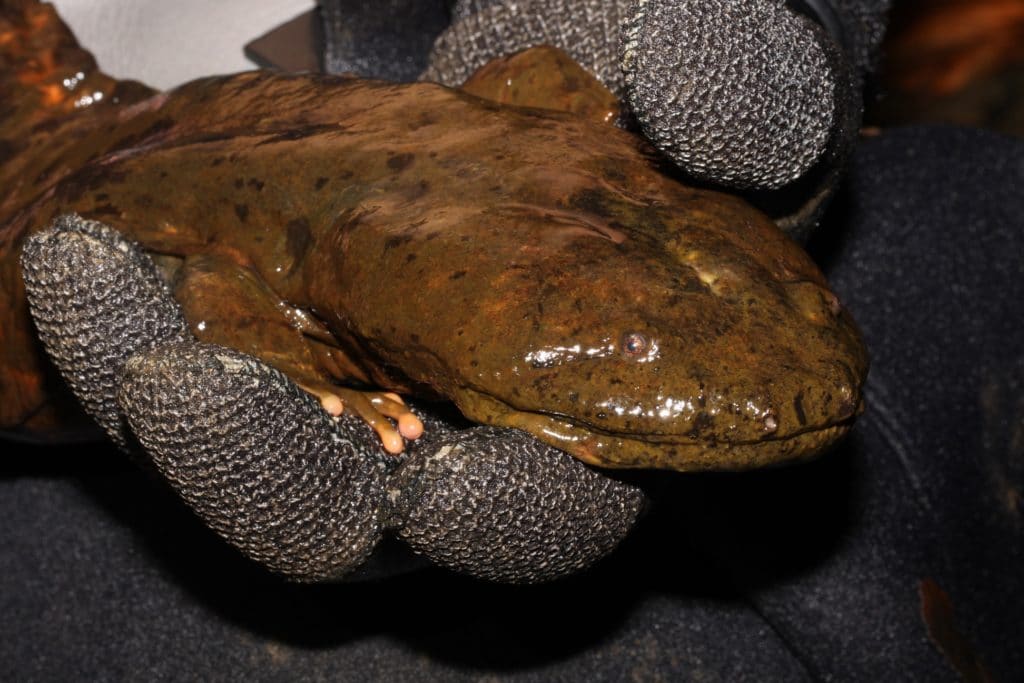
Hellbenders are super sensitive to silt, sedimentation and water pollution.
Because of this, they are referred to as biological indicators of water quality. As the N.C. Wildlife Resource Commission profile of the Eastern hellbender notes, “In other words, if there is a healthy hellbender population in a stream, there is clean water.”
Some of the best hellbender populations in North Carolina occur in the Upper Watauga River and North Carolina has, in turn, perhaps the best overall hellbender population of any state, according to Lori Williams, a Wildlife Diversity Biologist with the N.C. Wildlife Resources Commission.
With the Watauga River starting as a spring near Grandfather Mountain State Park and Boone Fork coming from the Blue Ridge Parkway and merging with the Watauga River downstream of Foscoe, the headwaters are protected.
“It’s almost a tale of two cities in some ways,” Williams said.
As you go downstream Watauga River and get closer to Valle Crucis, the hellbenders are “very, very few and far between.”
Some of this has to do with the geography of the river in Valle Crucis and Sugar Grove. Here, the river is flatter and the water is warmer.
“It’s also probably legacy effects of long term agriculture use and development. Seems like we are getting more really heavy storms and flood events frequently these days in the last 10 to 15 years,” Williams said. “You know when those hit, they can flush out a system, which may be good, but that mobilizes a lot of sediment and sends it downstream.”
Water impoundments are also threats to hellbender populations. Dams stop the flow of water and in turn the dissolved oxygen hellbenders absorb drops. Dams also warm the water. In short, they are unsuitable habitats for hellbenders.
Along the Watauga River in Sugar Grove, the historic Ward’s Mill Dam is being removed this fall.
Williams expects short term havoc in the river when the dam is removed and overall long-term benefits like restoring connectivity and improving water quality and the hellbender’s habitat.
But she also said time will tell how the river adapts once the dammed-up water is free.
“It can be a while before the river decides what personality it wants to take on,” Williams said.
Watauga Riverkeeper Watches Over Mighty Hellbender
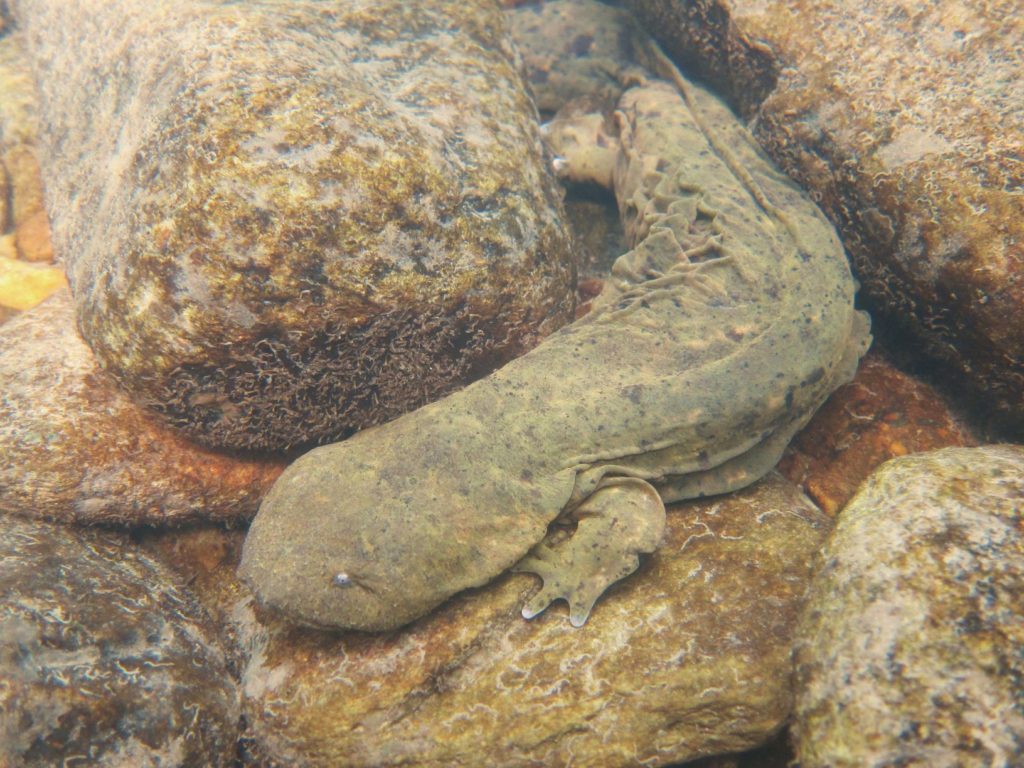
Helping to secure the future removal of the dam was Mountain True and its watchdog program Watauga Riverkeeper, which partnered with American Rivers, Blue Ridge Resource Conservation and government entities.
Watauga Riverkeeper Andy Hill said another way to help the threatened hellbender is to build and maintain a robust riparian buffer. This is a vegetated area along the riverbank and filters silt, sediment and stormwater.
This buffer helps to keep the rivers running clean, a necessity for the hellbender and its habitat.
For one, this prevents sediment from filling the spaces between rocks that serve as the home of the hellbender. It also prevents the suffocation of the hellbender’s food supply of macro invertebrates, crayfish and native fish species, Hill said.
Mountain True’s Watauga Riverkeeper tracks pollution using its Muddy Water Watch App and Swim Guide.
It also has a Shade our Stream program, which prioritizes streamside restoration through intensive plantings. With volunteers, they plant 10,000 native trees a year along the Watauga River and its tributaries.
“Our hope is that restoring riparian habitat and addressing pollution will help protect the hellbender,” Hill said.
Long-Term Inventory, Monitoring Project for NC Hellbenders
Since 2007, the NCWRC has conducted a long-term inventory and monitoring project for hellbenders. Recreationalists on the river and anglers report sightings.
Last year, more than 200 verified reports came in, and more than 100 reports have been submitted in 2020, on pace to exceed last year’s results. A few of the reports from 2020 are from the Watauga River.
“This year has been curtailed a bit because of Covid-19 restrictions, but people are still out on the water, so they are generating data for us,” Williams said. “We really rely on that kind of citizen-science approach.”
During the same year that the NCWRC started monitoring hellbenders, the commission also began running ads in wildlife publications to target trout anglers. Hellbenders and trout frequent the same waters, and always up for an easy meal, hellbenders don’t hesitate to bite a trout on a stringer.
Because of how big, odd and even scary these giant salamanders can appear, they’ve been known to frighten people – given colorful names such as the devil dog, snot otter and Alleghany alligator. A misconception or myth of the past is that the hellbender is poisonous or venomous – and also eats all of the trout.
“Some anglers think that’s gotten better over the years,” Williams said. “When people, say, you know, my friend or my fishing buddy told me not to hurt those animals and report a sighting, that’s a great sign of success.”
Endangered or Not?
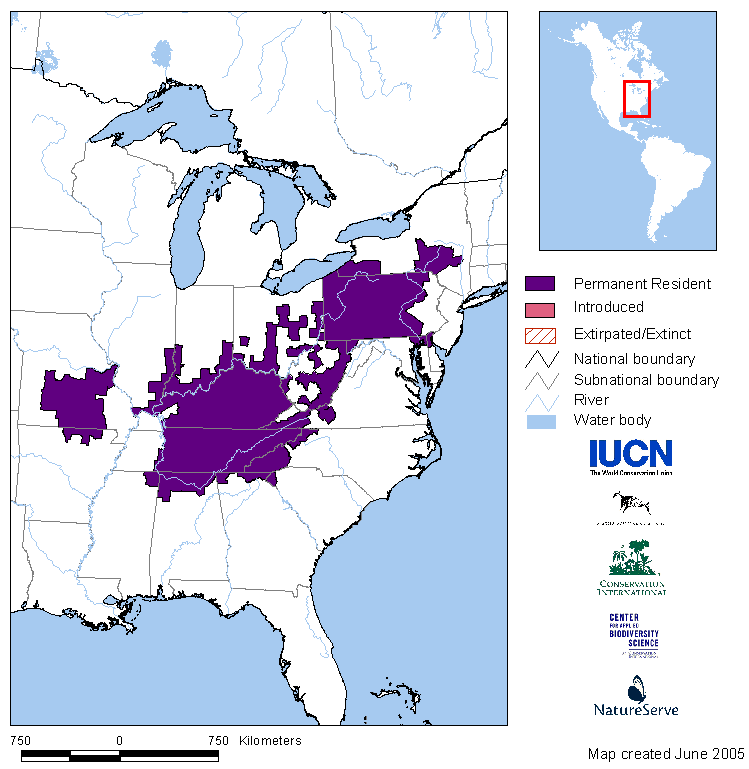
The N.C. Wildlife Resources Commission designated the hellbender as a species of Special Concern. As a protected species, it is illegal to kill, harm, collect, harass or sell hellbenders. Tennessee, where the Watauga River flows for 19 miles below the lake, lists them as in “Need of Management.”
Last year, the U.S. Fish and Wildlife Service (UFWS) elected not to protect the hellbender under the Endangered Species Act. (The Eastern hellbender is not to be confused for the Ozark subspecies that is currently designated by the federal government as endangered.)
As The Appalachian Voice reported last year, the Center for Biological Diversity (CBD) had strong words for the lack of federal protection on the Eastern hellbender. In 2010, the CBD initially petitioned the UFWS to list the Eastern hellbender under the Endangered Species Act, “stating that 78 percent of known hellbender populations have disappeared or are in decline.”
As for local trends, Williams said North Carolina has more individual streams with documented hellbenders than any other state. Having said that though, it appears the giant salamander populations are declining.
“We still are aware of streams where they’re just gone. Trying to estimate that – just a ball park, again without going through the rigorous statistical analysis – we put it somewhere between 15 to 20 percent and a decline at maybe another 30 to 40 percent of the sites.”